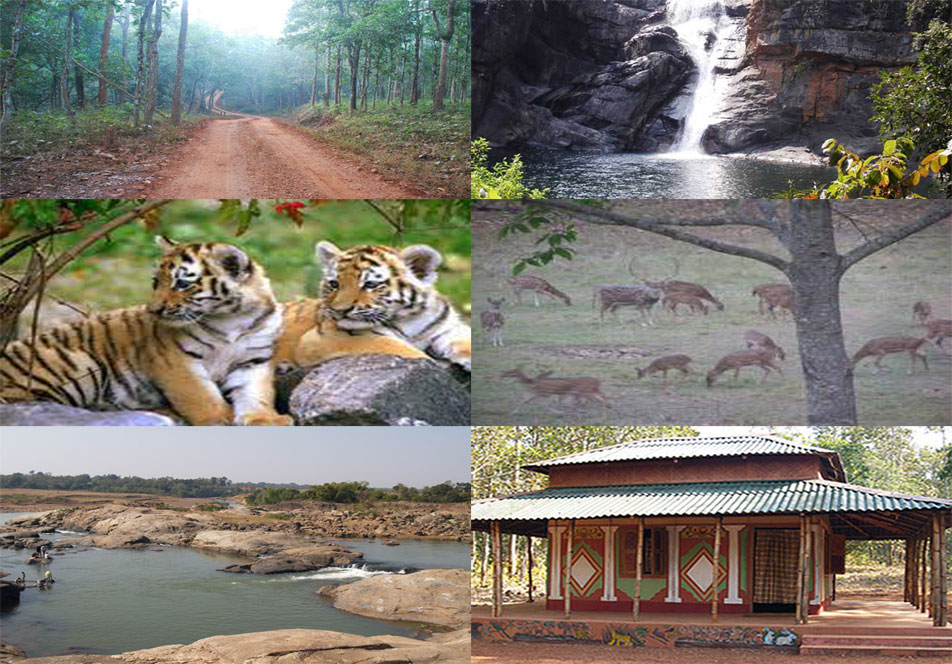Home ::Indian National Parks ::Simlipal National Park
Simlipal National Park
Simlipal National Park is a national park and an elephant reserve situated in the Mayurbhanj district in the Indian state of Odisha. Simlipal National Park derives its name from the abundance of Semul or red silk cotton trees that bloom vividly.
The park has an area of 845.70 square kilometres (326.53 sq mi) and has some beautiful waterfalls like Joranda and Barehipani. Simlipal is home to ninety-nine Royal Bengal Tigers, 432 Wild elephants. Besides Simlipal is famous for Gaurs (Indian Bisons), Chausingha, as well as an orchidarium.

One can enter into Similipal through Pithabata (22 kilometres (14 mi) from Baripada) and 98 km via Jashipur. Entry permits can be obtained from the Range Officer, Pithabata check gate upon paying prescribed fees. Day visitors can enter between 6 AM & 12 Noon and visitors with reservation between 6 AM & 9 AM. Similipal National Park remains open from 1 October to 15 June only.
Simlipal elephant reserve originated mainly as a hunting ground for the royalty. It was formally designated a tiger reserve in 1956 and under Project Tiger in May 1973. "Mugger Crocodile Scheme" was started in the year 1979 at Ramatirtha, Jashipur.

The park is located in the Mayurbhanj district in the Indian state of Odisha. Simlipal elephant Reserve is an ecosystem complete with forest vegetation (mainly sal trees), fauna and the adjoining Santhal tribal settlements. The park has a total area of 2,750 square kilometres (1,060 sq mi). The average elevation is 559.31 metres (1,835.0 ft). However, the entire Simlipal area is undulating, rising from 600 metres (2,000 ft) to 1,500 metres (4,900 ft). The high hills of Simlipal are surrounding Meghasani, the highest peak in the national park. At an altitude of 1,165 metres (3,822 ft), followed by Khairiburu at above 1,000 metres (3,300 ft) elevation. At least 12 rivers cut across the plain area. The prominent among them are Budhabalanga, Palpala Bandan, Kahairi and Deo. This sprawling forest also has many waterfalls such as, Joranda 493 feet (150 m) and Barehipani that are a perpetual attraction to the tourist, the latter at an elevation of 1,308 feet (399 m) gives a panoramic view of the park. It has withstood two cyclones in 1982 and 1999 without any prominent damages.
Summers are very hot with temperatures around 40 °C (104 °F) whereas the temperature during winter months can be as low as 14 °C (57 °F). The rainfall ranges from moderate to heavy. The park is a treasure house of 1076 species of plants belonging to 102 families. 96 species of orchids have also been identified here. It has a mixed type of vegetation known as Odisha semi-evergreen forests with tropical moist broadleaf forest and tropical moist deciduous forests with dry deciduous hill forest and high level Sal forests. The grasslands and the savannas provide grazing grounds for the herbivores and hiding place to the carnivores. The forest boasts of innumerable medicinal and aromatic plants, which provide a source of earnings for the tribal people. Eucalyptus, plantated by the British during the 1900 are also found.
A total of 42 species of mammals, 242 species of birds and 30 species of reptiles have been recorded in Simlipal National Park. The major mammals include Tiger, Leopard, Asian elephant, Sambar, Barking deer, Gaur, Jungle cat, Wild boar, Chausingha (four horned antelope), Giant squirrel and Common langur. 231 species of birds nest in these forests. Red Junglefowl, Hill Mynah, Peacock, Alexandrine Parakeet, Crested Serpent Eagle are the commonly found birds. The Grey Hornbill, Indian Pied Hornbill, Malabar Pied Hornbill and Indian Trogon are also found in the reserve. Apart from the large number of mammals and bird species, the park has a sizeable population of reptiles, which includes snakes and turtles. The "Mugger Crocodile Management Programme" has helped the Mugger crocodile (Crocodylus palustris) to survive and flourish on the banks of Khairi river.



